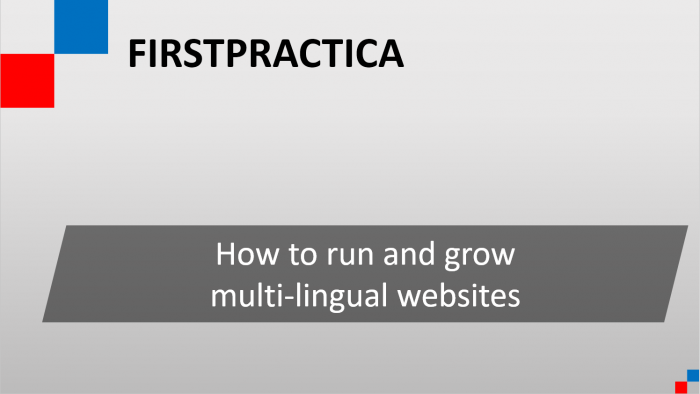
The times of creating and selling products and services locally or nationally are those of the former centuries. In a global economy, if what you produce has value to a particular customer speaking one language, it’s quite likely that someone speaking a different language will share the same interest. A multi lingual website can make sense. In this post we go through the technical considerations when setting up sites and expanding internationally.
Producing content in multiple languages allows you to expand the reach of your content. Doing this represents a lot of work: you need to find multi-lingual collaborators. Translating content can be done automatically with web services. But what will replace something written by a human being? For simple content like press releases, corporate earnings announcements, these are things that can be easily automated. “For the first quarter of 2017 sales grew from the previous period to $100,000” can be automated as “For [sales_current_time_period] sales [if sales_current_time_period > sales_past_time_period output “grew from the last period to”] [sales_previous_period]”. Software that automatically writes sports news reports or financial news already exists, and when it works it read just like a human being wrote it. But you still humans to proofread the content. You still need humans to answer comments. You may also want, even a robot would do the job, for humans to put a human touch to your content. In other words, creating and maintaining multi-lingual content is not just about translations. Consider how high of a priority this is relative to everything else you can do. If you decide that it worth it here are some decisions you will need to take in how you structure your content management system, like WordPress, and your websites.
Multi-site or individual sites
WordPress has settings for its software: a single site version, and a multi-site version. Going from single site to multi-site requires a few code changes and the creation of a network. The main difference between a single and multi-site is that a single site gives you full control on customization, which themes and plugins you use, and you are guaranteed that plugins that work on single site implementations will not have an issue when going to multi-site. In other words, not all plugins are tested or fully functional on multi-site. However, by going multi-site all your sites will share one database and one wordpress install. This means fewer credentials, less maintenance to carry. If you need to 100 sites, the case for multi-site is strong. Do you really want to manage 100 databases and 100 wordpress installs? But if you have 10 sites and you want each of them to have full freedom on which plugin and theme you run, you can then customize each install exactly to your liking with nothing in the way, other than the additional time, setup and maintenance. It’s feasible to maintain 10-20 sites, but it’s work.
Subdomain or folders
Another consideration is how you want your sites to be organized within your domain. Do you want site1.yourdomain.com, site2.yourdomain.com etc? This path uses sub-domains. Sub-domains are interesting because they allow you to play with DNS settings, for example handling traffic differently from your CDN. You can host site1 on one server, site2 on another server. That’s not possible when you choose the alternative method, using folders. In that case your sites will look like yourdomain.com/site1/, yourdomain.com/site2/. The advantage of doing this is DNS simplification: you direct traffic to yourdomain.com.
Multi-lingual keyboard
Operating in multiple languages can be done with an English-only QWERTY keyboard, or whichever keyboard you like for a given language. But as you operate sites in multiple languages, you will often benefit from being able to write a few words or lots of text in multiple languages. Take Spanish or French: many words contain accents, and that’s the case for dozens of other languages. If you need to edit a title or do anything that needs accents, you can map keys virtually, but unless you’ve got just a few it’s not practical. Multi-lingual keyboards are the way to go, don’t cost much and will save you time.
Translation plugins or not, and SEO considerations
As you go through the decisions in implementing multiple languages you’ll also need to consider whether you want to use plugins for translations. Some plugins do the actual translation from one language to another. Other plugins create and store content within the same post ID, automatically change the URLs for each language, and add the required metadata cross linking between same post in different languages. WordPress docs have a good article on multi-lingual implementations and how to decide, highlighting the latest plugins. If you go with single sites you may need no extra plugin, therefore you will not have that dependency. Ask yourself: if a plugin stores your post content in a unique way and one day you uninstall that plugin, what happens to your posts? How easy or hard will it be to move that data back to standard format? Finally, whichever implementation you choose with or without plugins consider Google’s recommended best practices in structuring a multi-lingual site.

Leave a Reply